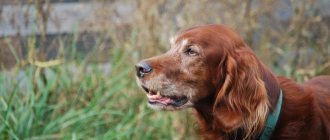| Origin: | England |
| Usage: | gun dog for bird hunting |
| Color: | black, orange, lemon and brown speckled or speckled (black or brown) and tan |
| Dimensions: | 65 – 68 cm and 27 – 30 kg males, 61 – 65 cm and 25.5 – 28 kg females |
| Lifespan: | up to 15 years, average – 11 years |
The English Setter is an amazing breed.
She combines playfulness and aristocratic manners, immense love for people and the passion of a hunter, childish mischief and devotion, elegant appearance and tirelessness. Setters are wonderful companions. Many people start them. But it should be remembered that dogs love hunting no less than people. Just games and walks are not enough for them.
Appearance and standard
The FCI approved the English Setter breed standard in 2009. He describes the dog as hardy, passionate, lean, with well-developed muscles. The dog is friendly and non-aggressive towards people and animals.
| Parameter | English Setter Standard |
| Frame | Elongated, strong. The back is straight, the chest is deep, the ribs are convex, the neck is long. The stomach is slightly tucked. |
| Head | Oval in shape, the back of the head and eyebrows are pronounced. |
| Bite | Scissor-shaped, complete dentition. |
| Ears | Hanging, medium length, thin, round. Stand at eye level or slightly lower. Covered with 5–8 cm of fur. |
| Eyes | Large, evenly spaced. Brown, preferably dark shades. Eyelids to match the suit. The expression is kind and intelligent. |
| Nose | Black or brown, fully pigmented. |
| Limbs | Long, evenly set, parallel, with prominent muscles. Elbows clasp the body and look back. |
| Paws | In a ball, oval, straight hair grows between the toes. |
| Tail | Set below the line of the back, saber-shaped or straight, tapering towards the end. In an excited state, the dog lifts it up to its back and waves cheerfully when walking. |
| Wool | Thick, silky, long and straight. Feathers on the ears, limbs, lower chest and tail, “pants” on the hips, feathers on the tail. |
| Color | Pure white and steel with small spots on the legs; white with blue, black, liver, orange, lemon specks; white with black or orange spots or specks and tan. |
An English Setter dog during a hunt is an incomparable spectacle. She walks at a creeping gallop, the so-called. shuttle When it smells prey, it takes a cat-like step. Approaching the bird, it freezes and makes a stance - lying or standing.
History of the Irish Setter breed
Irish Setter
The Irish Red Setter is one of the most “secret” hunting breeds, the first written mentions of which date back to the 15th century. At first, the term “setter” did not denote a specific type of dog, but entire groups of animals whose main qualification was working with wild birds. In particular, setters were often involved in hunting partridges with a net. Possessing an extremely acute sense of smell, the dogs always accurately determined the location of prey and indicated the direction to it, performing the function of a living navigator.
Little is known about the Irish Setters' closest relatives. There is an assumption that the blood of several varieties of spaniels, bloodhounds, pointers and even wolfhounds flows in the veins of modern representatives of the breed. However, it has still not been possible to actually confirm the guesses. The purposeful breeding of hunting dogs with reddish-chestnut fur in Ireland began at the end of the 18th century, as evidenced by the stud books of those years. However, until the middle of the 19th century, the breed was not considered mature, so in the rings the animals performed in groups with other varieties of setters. The official starting point for the history of the breed is considered to be 1860, when it was decided to separate the Irish Setters into a separate type. In 1882, the first club for “Red Irish” fans opened in Dublin, and three years later the same organization issued the first breed standard.
Interesting fact: at the turn of the XIX-XX centuries. In Europe, they practiced crossing the show and hunting varieties of the Irish Setter. Such experiments entailed a number of problems, including the degeneration of the animals' breed traits, which is why matings between working and show lines had to be stopped. American breeders, on the contrary, were keen on improving mainly show animals, so today’s “Irish” made in the USA are somewhat different from their overseas compatriots.
In Russia, Irish setters were known even before the revolution. Moreover, elite nurseries operated in the country, patronized by members of princely families. But even after the change in the political system, they did not forget about the breed: they continued not only to breed it, but also to actively improve it, importing purebred European producers into the Union. For example, A. Ya. Pegov, a professional breeder and author of the book “The Irish Setter,” which became the “bible” of domestic dog breeders for more than half a century, played an outstanding role in the popularization of the “Irish” in the USSR.
It is worth noting that in Russia the emphasis has always been on breeding animals of hunting lines, which means that domestic livestock has never traveled to international exhibitions. Later, Pegov’s baton was picked up by E.E. Klein and T.N. Krom, who modified the type of dogs towards a drier and more muscular one, which allowed the Soviet setters to get a little closer to the Anglo-Irish breed ideal.
Video: Irish Setter
Character traits
“There is no dog better than an English setter” – this is the description given by the owners’ reviews. The pet really has an angelic character. There is not a drop of malice in him, he is a selflessly loving animal and a courteous owner. He “receives” guests with people, talks with them, and is not averse to jumping into a stranger’s arms and licking him.
The dog is attached to his family and owner. It is not recommended to leave him alone for more than a couple of 2 - 3 hours: the pet begins to worry and falls into frustration.
English setters are sociable. They follow their owner's heels and participate in household chores. At the same time, pets understand when a person is tired, angry or not in the mood - at such moments they are not intrusive.
Dogs are not touchy. But you cannot treat them cruelly - the animals will become restless, intimidated, and aggression may appear against a background of fear.
Basic moments
- Representatives of the breed are known for their endurance, which will appeal to active owners. If they are not interested in hunting, then playing sports together with a four-legged partner will be a worthy replacement.
- The elegant appearance of the English Setter also deserves attention. The pet’s beautiful coat, combined with its grace and aristocracy, attracts everyone’s attention.
- Among the advantages of the breed are well-developed intelligence and quick wit. This trait is especially valued by hunting fans and dog breeders who train future champions.
- The pet will not nap throughout the day. He is not characterized by laziness; sitting in one place for a long time is an almost impossible task. But, despite all their energy, setters behave in an extremely well-mannered manner. They will not pester the owner and impose their company if they see that he is busy.
- Setters are far from the only breed that analyzes human behavior and is capable of providing support, but it is in them that these talents are especially strongly developed. They are also very sociable, which will appeal to the rest of the household, because the dog has both the energy and the desire to spend time with each of them.
- The pet has developed hunting instincts, but they are used only when catching prey. At home, they are cheerful, good-natured and do not show aggression towards strangers or other animals.
- It doesn’t matter whether the owner lives alone or with his family, he won’t be bored. Setters are not inclined to distance themselves from their household members and are happy to take part in everything that happens in the apartment.
- The list of advantages of individuals of this breed cannot include working as a watchman. The dog is not suitable for attentive “vigilance”, and it would rather “kiss” a stranger than prevent him from entering the territory.
- The pet will not only participate in all kinds of children's games, but will also look after the kids, and therefore will fit perfectly into a family with small children.
- Setters do not strive to take a dominant position and compete for the owner’s attention, and therefore get along well in the same territory with cats or other pets.
- Living conditions for the animal should be chosen based on its line. An exhibition dog will feel comfortable in an apartment, but a working dog needs a lot of space and the opportunity to stretch its paws.
- Training English Setters is not an easy task. Although dogs are highly intelligent, they also have a stubborn streak that makes them difficult to handle.
- Beginning dog owners may be intimidated by the need for meticulous daily grooming.
Relationships with animals and children
The breed was bred to prevent aggression and dominance. Therefore, dogs do not have conflicts. There are no clashes even between male dogs.
Setters love to play with other dogs. They are not averse to frolicking with cats: these pets get along well with each other.
But communication with domestic rodents and birds is difficult. The English cops consider them prey. They will not kill the animals, but will follow throughout the house and make stands.
True, English setters get used to “their” rabbits and parrots after a while and stop chasing “game” from corner to corner. But street and foreign rodents and birds are considered legal prey.
There is no better friend for children than an English setter. Two irrepressible robbers become an excellent tandem for mischief and pranks. The dog will never bite or even bare its teeth at the baby. But a baby under 6–9 years old should not be left alone with a pet: the first one can injure the dog, and the second one can accidentally push the child.
Hunting with an Irish Setter
Irish Setter on the hunt
The main hunting prey of the Irish Red Setter are partridges, quails, corncrakes, black grouse, ducks and woodcocks. The breed is adventurous, easy-going and relatively manageable, but not as patient as we would like. The dog works relying mainly on instinct, using hearing and vision to a minimum. As a result: during long aimless wanderings through the fields, the four-legged miner does not receive enough impressions, so he loses interest in work and switches to another type of activity. It is advisable to hunt with an Irish setter only in proven places where feathered trophies definitely live. If you need a “scout” who is more consistent and focused on the search process, it is better to pay attention to the English setter.
Upbringing
English setters are dogs of one owner. From the first day the puppy is in the house, one person should take care and feed it.
Setters almost never do any harm. Chewed furniture, torn curtains and uprooted flowers - this is not about them. But they need clear rules - if dogs are not allowed to do something, then forever - and vice versa.
Pets are obedient and easy to train. But they are often distracted by sounds and smells. Some animals are stubborn and may not follow commands.
Training is presented in the form of a game or imitation of hunting. No rudeness, monotonous repetition of commands or strict demands. Only affection and encouragement. And for punishment, a strict tone is enough.
The description of the breed says that English pointers consider themselves friends of man, and behave on an equal footing with their owner. They are more likely to respond to the phrase “Come here” than to the command “Come to me.”
Kinds
There are several classic types of setters:
- Irish.
- Scottish.
- Gordon.
- English.
Each of them has a specific hunting talent and coat color. The Irish Setter has no varieties. The breed has a standard that is generally recognized. The main indicator of a purebred dog is bright red fur, less often chestnut. If an animal has white-red or black spots on its body, it is probably another type of setter.
Application
Initially, the animals were used as gun dogs. But today they are more often taken as companions.
If you need a friend, not a hunter, you should take a show line dog. She doesn't need to run for 12 hours to burn off energy. She is calmer, looks more beautiful, and can sublimate hunting with stances on pigeons and other urban birds.
If you want to hunt game, then you need to buy a dog from hunter breeders. They raise excellent working dogs.
Due to the lack of aggression, there are no watchmen or guards from pets. They would rather kiss a robber than bark at him.
Features of maintenance and care
The photo of the English Setter is worthy of the cover of fashion magazines. But beauty takes time and money. You need to take care of your dog every day and for more than one hour.
Grooming
Cosmetic procedures take a lot of time and effort. Need to:
- Brush your English Setter every day with a long-toothed natural bristle comb and a massage brush - the long hair gets tangled, dirty, and tangled;
- inspect and clean your ears every day - they are long, mites settle in them and dirt gets clogged, without care otitis media develops;
- Brush your teeth 2 – 3 times a week;
- Trim nails once every one to two weeks;
- cut your dog's hair at a pet salon once every 1-1.5 months;
- Once a day, examine your eyes and wipe them from nitrous oxides.
Bathing
The setter needs to be washed every 10-14 days. The owner's arsenal should include:
- liquid shampoo for long-haired dogs prone to allergies;
- dry shampoo - if the dog rolls around in the mud before the next bath day;
- conditioner - apply it after swimming and wash off after 10 minutes;
- balm or rinse for wool.
Some owners do not recommend washing the English Setter more than once every 2 months.
Walk
English Setters are attracted to active people. Forays into nature, long walks in the park and groves are urgently needed for your pet.
The setter is tireless. He can run for hours and not even get out of breath. Therefore, you need to walk with your pet at least twice a day for 1 – 1.5 hours.
Show dogs are not as active as working dogs. The maintenance is simple - a spacious apartment and walking for 2 - 3 hours a day is enough. But working animals need a country home.
These pets do not tolerate heat and cold well. In the summer they make sure that the dogs do not overheat, and in the late autumn and winter they are dressed in waterproof overalls.
Feeding
The only thing there is no problem with is food. English Setters are unpretentious and eat whatever is offered. But their main advantage is a sense of proportion.
There is no need to focus on feeding standards. Dogs are not gluttons and determine their own portion sizes. If the pet does not eat the food in one “lick,” the amount of food is reduced. If he quickly swallows and licks the bowl for a long time, it means there is not enough food and you need to put more.
You can feed your pet ready-made dry or wet food or natural food. He needs a balanced diet based on lean meat with the addition of cereals, dairy products, vegetables, eggs, vegetable oils and fruits.
Nutrition
First of all, his health depends on the organization of the dog’s menu. If the dog is weak, lethargic or not playful enough, this may indicate insufficient intake of microelements.
In order for the Irish Setter to fully perform its hunting function, it must consume at least 700 grams of food rich in vitamins and carbohydrates daily (adult). Puppies should be fed frequently, namely 4-5 times a day. You should not allow them to eat before bed, as this will make it difficult for them to fall asleep.
The main food that a large breed dog should eat is raw chicken or beef. It is advisable to give him 200-300 grams of this product every morning. In the first half of the day, he should consume a large amount of carbohydrates, which his body will process into energy. Beagle dogs especially need calories, as they are characterized by mobility.
In addition to beef/rabbit/chicken, give your setter cottage cheese and cereals. You can boil buckwheat, rice, millet, but not barley, as it is difficult to digest. But treating your four-legged friend with sweets, such as chocolate or cream cookies, is strictly not recommended. Eating confectionery products can cause gastritis in a dog. We recommend feeding dry food to an adult dog.
Health
English Setters are a strong breed. They live up to 15 years. But due to numerous and uncontrolled breeding, hereditary diseases occur in pets. Such pets die at 9-11 years of age.
Diseases
Setters are susceptible to:
- pyometra;
- joint dysplasia;
- bone cancer;
- paresis and paralysis;
- allergies;
- volvulus;
- deafness;
- otitis media;
- vision problems;
- dermatitis;
- epilepsy.
Pets get cold easily, so owners make sure that they are not in a draft.
Vaccinations
Viral diseases are a rare situation, because English cops have strong immunity. But they, like all dogs, must be vaccinated against rabies, distemper, parainfluenza and other dangerous infections. Which ones are determined by the veterinarian depending on the epidemiological situation in the area.
Health and Diseases of Irish Setters
The health of the breed depends on how responsibly the nursery owner approaches its breeding. The same hereditary diseases may not manifest themselves in animals whose breeder does not skimp on genetic testing of the litter, scrupulously selects sires for mating and does not abuse inbreeding. And vice versa: Irish setters who are not too lucky with their owner and heredity may develop the following diseases:
- volvulus;
- epilepsy;
- hypothyroidism;
- malignant tumors (melanomas);
- entropion;
- hip dysplasia;
- allergic dermatitis;
- inflammatory processes in the uterus;
- pathologies of the spinal cord (degenerative myelopathy);
- congenital dilatation of the esophagus (idiopathic megaesophagus);
- hypertrophic osteodystrophy;
- laryngeal paralysis.
At the beginning of the 20th century, European breeders went too far with inbreeding, as a result of which the “Irish” suffered for a long time from progressive retinal atrophy. It was possible to eradicate the defect only after the development of a test system that helped identify the blindness gene in the early stages. Ultimately, defective individuals were no longer allowed for breeding, which reduced the risk of inheriting the disease.
Mating
Males and females are untied from the age of 2 years. Until this age, they are not fully formed and remain puppies.
The first heat in female dogs occurs at 6, 12 or 14 months. But they start breeding her on the third or fourth heat.
Estrus lasts 20–22 days. The ideal mating period is 11-15 days.
Females bear puppies for up to 65 days. Pregnant bitches increase the caloric intake of their diet and make sure that they do not leak. It is not recommended to wash the expectant mother. Jumping, going up and down stairs, and swimming in bodies of water are also prohibited.
Reproduction and lifespan
The Irish Setter is a noble and worthy dog. Only those representatives of which the breeder has no doubts about their pedigree should be bred. Before introducing a male dog to a female dog, you need to study their appearance. Dogs should not have any abnormalities. The color of their coat should be noticeable and shiny.
Setters are friendly dogs, but even they can be intolerant of each other. Owners of these dogs must present them. You should not force a male dog on a female dog; she must show interest in him on her own. By the way, this will not happen if mating is planned on its territory.
Animals must be given the opportunity to sniff each other. Once all the necessary information is collected through the nose, they will be ready to reproduce. There is no need to interfere with this process in any way.
Usually, during a normal pregnancy, puppies are born within 69-75 days after conception. It is not recommended to artificially induce labor in dogs.
But, if on the eve of the birth of the puppies, the Irish Setter bitch behaves restlessly, whines and does not let anyone near her, she will probably have a difficult birth. In this case, we recommend inviting a veterinarian. These beautiful and kind dogs live from 10 to 12 years.
How to choose a kitten
Since English Setters are bred by all and sundry, you need to find a trusted kennel. Good breeder:
- answers all questions with pleasure, even stupid ones;
- issues pedigrees and metrics for puppies;
- without fear he shows his parents, their documents and photos of the English setter - graduates of his kennel;
- draws up and signs a notarized agreement on the purchase and sale of a pet;
- does not give up puppies before 2 months;
- does not sell babies without vaccinations and anti-parasitic treatment.
English Setter puppies, like Dalmatians, are born without characteristic spots.
The specks will appear later. When examining the kittens, it is necessary to clarify whether there are babies with congenital pathologies, and whether there were such in previous litters.
A calm, moderately active English Setter puppy is suitable for a family.
Interesting facts about the English Setter
- In the popular film “White Bim Black Ear” it was said that the main character belongs to the Scottish Setter breed. After the release of the film, its specimens became extremely popular, and many children dreamed of such a pet. In fact, the role of Bim was played by an English setter.
- In the late 1990s, the breed gained renewed attention following the release of the "Chappi" advertisement.
- A big fan of hunting, Edward Laverack lived in the English village of Belton, where he worked for many years to increase the number of English setters. He is the author of the term "Belton", which is used to describe the speckled coat of the breed.
- During outdoor recreation, your dog must be closely monitored. A sociable pet can easily go to neighboring companies and steal food or some other thing from there, which it will bring to the owner as prey.
How much do puppies cost?
The English Setter is an inexpensive breed.
The average price of a breed-class dog is 20-30 thousand rubles. Show-class English Setter puppies are more expensive – from 45 to 80 thousand rubles. You can get a friend even cheaper if you buy him at a poultry market or secondhand - for 2 - 10 thousand rubles. But there is no need to take that risk. It is better to purchase a pet-class kitten from an official nursery. It costs about 15,000 rubles. The baby may have flaws in appearance, but he is healthy.
In Russia, the following nurseries sell purebred English Setters:
- https://www.english-setter.ru/index.htm – Russian club of the English Setter breed, located in Moscow;
- https://www.kamhunting.ru – breeds working lines of English setters and pointers, located in Moscow Region.
The English Setter is a sensitive and loving friend. It's more than a dog. He will become a full member of the family for 10-15 years.











